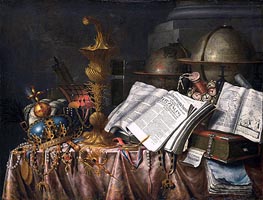
Edwaert Collier Giclée Fine Art Prints
1642-1708
Edwaert Collier - or Evert, or Edward, depending on the mood of history’s spelling habits - was a painter who knew how to make objects speak. Born in Breda on January 26, 1642, Collier’s career spanned the Dutch Golden Age and took him across the North Sea to England. He became a master of still life, carving a niche in the realm of vanitas and trompe-l'œil, those genres where inanimate objects suddenly feel more alive than ever - and perhaps more fleeting, too.
Trained in Haarlem, Collier’s early works show the distinct influence of his likely teacher, Vincent Laurensz van der Vinne, himself a notable still-life painter of the time. It was in Haarlem that Collier first registered with the local Guild of St. Luke in 1664. Like so many of his contemporaries, Collier was a restless spirit, always on the move - from Haarlem to Leiden, and later to Amsterdam. By 1693, he found himself in London, where his name would become associated with a distinctly English flavor of trompe-l'œil. His works from this period, signed and dated in both Leiden and London, trace his constant back-and-forth between these cities.
What sets Collier apart in the still-life tradition is his fascination with ephemera - the letters, medals, and bits of paper that clutter our lives and mark our passage through the world. His canvases are like letter racks frozen in time, every scrap meticulously arranged to "pop" out of the frame, teasing the eye with their startling realism. Dror Wahrman, in his book "Mr. Collier’s Letter Racks", delves into these intricate compositions, highlighting how Collier took the old tradition of "memento mori" and modernized it. His art wasn’t just about death and decay, but about life’s passing distractions, the fragile tokens we leave behind.
Collier’s trompe-l'œil works, with their lifelike depictions of popular prints, journals, and engravings, invite viewers to question the very nature of reality. They are puzzles for the mind, illusions for the eye - but more than that, they are reminders of the transient nature of material things. His mastery of detail, the subtle play of light on a sheet of paper, or the shadow cast by a seal, elevates the mundane into the profound. Edwaert Collier passed away in 1708, buried in London at St. James’s, Piccadilly, but his art continues to draw us in, reminding us that in the end, even the most ordinary of objects can be extraordinary.
Trained in Haarlem, Collier’s early works show the distinct influence of his likely teacher, Vincent Laurensz van der Vinne, himself a notable still-life painter of the time. It was in Haarlem that Collier first registered with the local Guild of St. Luke in 1664. Like so many of his contemporaries, Collier was a restless spirit, always on the move - from Haarlem to Leiden, and later to Amsterdam. By 1693, he found himself in London, where his name would become associated with a distinctly English flavor of trompe-l'œil. His works from this period, signed and dated in both Leiden and London, trace his constant back-and-forth between these cities.
What sets Collier apart in the still-life tradition is his fascination with ephemera - the letters, medals, and bits of paper that clutter our lives and mark our passage through the world. His canvases are like letter racks frozen in time, every scrap meticulously arranged to "pop" out of the frame, teasing the eye with their startling realism. Dror Wahrman, in his book "Mr. Collier’s Letter Racks", delves into these intricate compositions, highlighting how Collier took the old tradition of "memento mori" and modernized it. His art wasn’t just about death and decay, but about life’s passing distractions, the fragile tokens we leave behind.
Collier’s trompe-l'œil works, with their lifelike depictions of popular prints, journals, and engravings, invite viewers to question the very nature of reality. They are puzzles for the mind, illusions for the eye - but more than that, they are reminders of the transient nature of material things. His mastery of detail, the subtle play of light on a sheet of paper, or the shadow cast by a seal, elevates the mundane into the profound. Edwaert Collier passed away in 1708, buried in London at St. James’s, Piccadilly, but his art continues to draw us in, reminding us that in the end, even the most ordinary of objects can be extraordinary.
1 Edwaert Collier Artworks

Giclée Canvas Print
$62.93
$62.93
SKU: 13451-COE
Edwaert Collier
Original Size:102.5 x 132 cm
Rijksmuseum, Amsterdam, Netherlands
Edwaert Collier
Original Size:102.5 x 132 cm
Rijksmuseum, Amsterdam, Netherlands